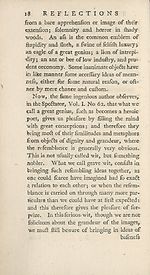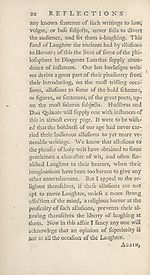Download files
Complete book:
Individual page:
Thumbnail gallery: Grid view | List view

UPON LAUGHTER. 19
bafenefs or deformity, unlefs we are ftudying
to repreient an objeft as bale and deformed.
Now this fort of wit is feldom apt to move
Laughter, more than heroic poetry.
That then which fee ms generally the caufe
cf Laughter, is “ the bringing together of i-
“ mages which have contrary additional ide-
“ as, as well as feme refemblance in the prin-
“ cipal idea: this contraft between ideas of
“ grandeur, dignity, fanftity, perfe£ik»n, and
“ ideasofmeannefs, bafenefs, profanity, feems
“ to be the very fpirit of burlefque; and the
“ greateft part of our raillery and jell is
“ founded upon it.”
\V e alfb find ourfelves moved to Laughter
by an overftraining of wit, by bringing refem-
blances from fubjefts of a quite different kind
from the fubjecl to which they are compared.
“ When we fee, inflead of the eafmefs, and
“ natural refemblance, which conftitutes true
“ wit, a forced ftraining of a likenefs, our
“ Laughter is apt to arife; as alfb, when the
“ only refemblance is not in the idea, but in
“ the found of the words.” And this is the
matter of Laughter in the pun.
Let us fee if this thought may not be con¬
firmed in many inflances. If any writing has
obtained an high character for grandeur, fan-
ftity, infpiration, or fublirn.ty of thoughts,
and boldnefs of images; the application of
any
bafenefs or deformity, unlefs we are ftudying
to repreient an objeft as bale and deformed.
Now this fort of wit is feldom apt to move
Laughter, more than heroic poetry.
That then which fee ms generally the caufe
cf Laughter, is “ the bringing together of i-
“ mages which have contrary additional ide-
“ as, as well as feme refemblance in the prin-
“ cipal idea: this contraft between ideas of
“ grandeur, dignity, fanftity, perfe£ik»n, and
“ ideasofmeannefs, bafenefs, profanity, feems
“ to be the very fpirit of burlefque; and the
“ greateft part of our raillery and jell is
“ founded upon it.”
\V e alfb find ourfelves moved to Laughter
by an overftraining of wit, by bringing refem-
blances from fubjefts of a quite different kind
from the fubjecl to which they are compared.
“ When we fee, inflead of the eafmefs, and
“ natural refemblance, which conftitutes true
“ wit, a forced ftraining of a likenefs, our
“ Laughter is apt to arife; as alfb, when the
“ only refemblance is not in the idea, but in
“ the found of the words.” And this is the
matter of Laughter in the pun.
Let us fee if this thought may not be con¬
firmed in many inflances. If any writing has
obtained an high character for grandeur, fan-
ftity, infpiration, or fublirn.ty of thoughts,
and boldnefs of images; the application of
any
Set display mode to:
![]() Universal Viewer |
Universal Viewer | ![]() Mirador |
Large image | Transcription
Mirador |
Large image | Transcription
| Antiquarian books of Scotland > Curiosities & wonders > Reflections upon laughter > (27) |
|---|
| Permanent URL | https://digital.nls.uk/119117816 |
|---|
| Description | Thousands of printed books from the Antiquarian Books of Scotland collection which dates from 1641 to the 1980s. The collection consists of 14,800 books which were published in Scotland or have a Scottish connection, e.g. through the author, printer or owner. Subjects covered include sport, education, diseases, adventure, occupations, Jacobites, politics and religion. Among the 29 languages represented are English, Gaelic, Italian, French, Russian and Swedish. |
|---|

